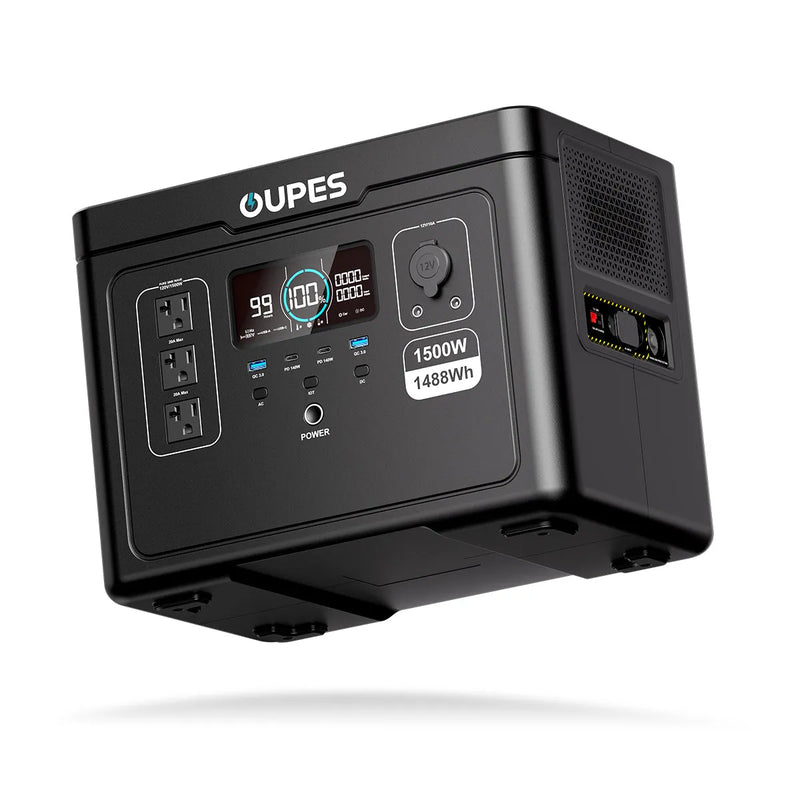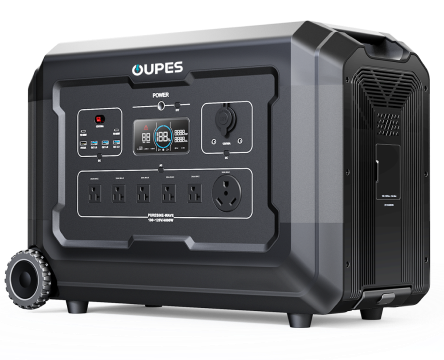
Imagine a sudden summer storm knocks out power just as dinner simmers on the stove, or you're deep in the wilderness craving more than cold trail mix. That humble 1500-watt generator humming in your garage or RV could be your lifeline to normalcy. Portable generators in this power class—often called "suitcase generators" for their compact size—occupy a sweet spot between capability and convenience, offering enough electricity for essential appliances without requiring industrial strength. Whether facing unexpected blackouts, powering your camping adventures, or running tools at a remote job site, understanding a 1500-watt generator's true potential means unlocking reliable backup power tailored to modern needs. What exactly can this popular powerplant sustain? The answer reveals surprising versatility when you master the crucial difference between starting watts and running watts, strategically prioritize devices, and avoid potentially dangerous overloads.
Understanding Generator Capacity: Starting vs Running Watts
Before plugging devices into a 1500-watt generator, you must decode the dual metrics governing its capabilities: running watts and starting watts. Running watts represent the continuous power output that maintains already-operating appliances—the steady-state electricity for your refrigerator's compressor or your living room lamp. Your generator's rated capacity primarily refers to this sustained output. Crucially, many motor-driven appliances demand significantly higher starting watts (or surge watts) when initially powered on. This temporary spike, lasting seconds but sometimes reaching triple the running wattage, allows electric motors to overcome inertia and reach operating speed. Failing to accommodate these surges represents the most common generator overload scenario, often causing shutdowns or damaging delicate electronics. Manufacturers typically list both specifications—your 1500-watt generator might offer 1500 running watts with 1800 starting watts, or 1500 watts continuous with 2000 peak.
Calculating your actual power requirements requires careful aggregation of starting and running demands. Begin by identifying which devices will operate simultaneously. List their running wattage requirements—often found on manufacturer labels or specification sheets. Next, determine which motorized devices start under load during this simultaneous operation period. Add the single highest starting wattage requirement to the total running wattage of all concurrent devices. This sum must not exceed your generator's rated starting wattage capacity. For mixed-use scenarios, like running a refrigerator alongside electronics, note that the refrigerator's compressor cycles off periodically, creating temporary capacity for other surge loads. Always prioritize starting the largest motor first when sequencing device activation manually. Neglecting this critical distinction between continuous and surge power represents the primary reason generators fail when needed most, making this knowledge foundation non-negotiable.
Essential Appliances and Devices Within Reach
A properly managed 1500-watt generator transforms into a versatile power hub capable of sustaining fundamental household functions during outages. Refrigeration represents perhaps the most critical application: a modern 18-cubic-foot energy-efficient refrigerator typically requires 500-800 running watts and 1200-1500 starting watts. When operated as the sole major appliance (with surge accommodated during startup), your generator preserves perishables without breaking capacity. Similarly, freezers in the 5-7 cubic foot range demand 400-700 running watts with surges nearing 1000 watts—manageable as long as you avoid concurrent high-surge devices. Beyond food preservation, cooking appliances become feasible: an 800-watt microwave oven operates comfortably, while modest coffee makers (600-900 watts) and electric kettles (600-1200 watts) brew necessities—though not simultaneously with refrigeration demands. Strategic meal planning using these devices can prevent reliance on potentially unsafe outdoor grills.
For comfort and communication, your generator offers significant utility. Multiple LED lighting circuits consume minimal power—an entire home's worth of LEDs might use less than 100 watts combined. Critical medical devices like CPAP machines (30-60 watts) or oxygen concentrators (300-600 watts) maintain operation with substantial capacity to spare. Electronics thrive on this clean power tier: laptops require 20-70 watts, phones under 10 watts, and Wi-Fi routers/modem combos draw 10-30 watts. A 42-inch LED television (80-150 watts) with a streaming stick (5 watts) creates entertainment access. Crucially, small heating and cooling devices operate effectively: box fans need 60-100 watts, portable ceramic heaters (with settings managed) draw up to 900 watts on low, and window AC units under 5000 BTUs require 400-600 running watts with manageable startups around 1000 surge watts—though AC runtime may preclude simultaneous refrigerator operation. This diverse coverage sustains livability during multi-hour interruptions.
Powering Outdoor Activities and DIY Projects
Beyond emergency scenarios, your 1500-watt generator empowers recreation and craftsmanship beyond electrical outlets. For camping enthusiasts or tailgating crowds, it becomes a mobile power station that beats solar panels on cloudy days. Compact coffee stations (400-800 watts), electric coolers (50-80 watts), and electric griddles (700-1200 watts) transform remote locations into comfortable basecamps while inflatable mattress pumps (100-200 watts) simplify setup. Outdoor lighting systems—including string lights (5-10 watts per bulb) and floodlights (50-150 watts)—create ambiance and safety at dusk. Entertainment needs are covered: projectors (200-300 watts) with speakers (50-100 watts) host impromptu movie nights. Just ensure gasoline storage follows strict safety protocols away from sleeping areas and open flames.
DIY professionals working at sites lacking grid access find indispensable support. Critical carpentry tools like miter saws (around 1000 running watts with 1500+ startup surge) operate effectively when used sequentially—provided you manage startup surges separately from other loads. Orbital sanders (200-400 watts), jigsaws (300-500 watts), and planers (700-1000 watts) maintain productivity. Pneumatic systems get support via compact air compressors (drawing 1000-1400 starting watts and 700-900 running watts for inflation tasks). Crucially, battery-charging ecosystems thrive: simultaneously recharging power drill batteries (50-100 watts each) alongside circular saw packs maximizes efficiency between cutting tasks. Finish work tools like paint sprayers (300-400 watts) and shop vacuums (500-800 watts with 1200+ surge) complete professional-grade results away from workshops. Always prioritize startup sequencing to avoid overload when transitioning between high-demand equipment.
Critical Limitations: What Exceeds 1500 Watts
Understanding what your generator cannot power proves equally vital to successful operation. Household systems requiring substantial 240-volt circuits lie completely beyond reach—electric ranges, ovens, dryers, and central air conditioners demand voltage and wattages impossible for 1500W portable generators. High-demand heating appliances become problematic: standard hair dryers (1200-1800 watts) might technically run on maximum settings but leave no buffer for other devices, while clothes irons (1000-1800 watts) become major power hogs when activated. Resistive heating elements in kettles or cooktops drain capacity rapidly due to absence of startup surge reduction—a microwave provides more cooking versatility per watt.
Regarding simultaneous operation, several common device combinations exceed safe capacity thresholds. Running a refrigerator simultaneously with either a microwave or coffee machine risks overload if all reach peak demand during compressor startups. Window air conditioning units above 5000 BTUs generally draw 800+ running watts with 1600+ starting surges—potentially overloading some 1500W generators at startup. Wet appliances pose particular risks: sump pumps present inconsistent loads depending on water volume and head height, with ⅓ horsepower models requiring 800 running watts and 1300+ startup watts. Attempting concurrent operation with nearly any other significant load risks failure during pump activation cycles. Multiple motor startups coinciding (like fridge and furnace blower or vacuum cleaner) will almost certainly exceed starting watt allowances. Crucially, well pumps vary by depth and horsepower—many shallow models exceed capacity, while deeper submersibles remain impossible without larger generators.
Optimizing Performance and Runtime Strategies
Maximizing your generator's effectiveness requires strategic power management techniques. Fuel type fundamentally impacts operation: gasoline models dominate this size class, offering wide availability but requiring fuel stabilization if stored beyond 30 days. Inverter generators using gasoline provide cleaner power ideal for sensitive electronics, typically yielding 3-8 hours per gallon at 50% load—calculate your expected outage duration against tank capacity. Strategically stagger motor startups: turn on your refrigerator first when nothing else runs, let it complete its startup surge and cooling cycle, then activate secondary devices like lighting or chargers once it settles into low running wattage. Document all your essential devices' running and starting wattages on a laminated quick-reference sheet stored with your generator for rapid decisions during chaotic outages.
For extended runtimes, conservation matters more than absolute capacity. A loaded refrigerator maintains safe temperatures for hours if opened minimally—monitor with battery-powered thermometers instead of constant operation. Use propane camp stoves instead of electric cooking elements when feasible. Prioritize LED lighting over legacy incandescent bulbs which waste 90% of energy as heat. Create charging stations rather than perpetual operation: power laptops to 80% charge then switch to phones. Inverter generators specifically allow for "eco-mode" activation which reduces engine speed (and noise/fuel consumption) during low-demand periods. Maintain maintenance vigilance: clean air filters every 50-100 hours, change oil every 100 hours or seasonally, and test monthly regardless of need. Always operate outdoors on non-flammable surfaces at least 20 feet from structures to prevent deadly carbon monoxide infiltration into living spaces. Installing battery-powered CO detectors provides critical backup safety.
Mastering your 1500-watt generator's capabilities transforms it from occasional tool to reliable power partner across diverse scenarios. By focusing on key appliances within its reach—refrigeration, critical electronics, small cooking devices, lighting, and communication equipment—you establish a foundation for emergency preparedness that keeps families safe during outages. Simultaneously, its portable nature makes it invaluable for recreational activities and remote professional tasks when grid power remains inaccessible. The constraints—especially regarding simultaneous high-demand appliances and larger heating/cooling systems—simply underscore the importance of strategic load management rather than indicating inadequacy.
Ultimately, success hinges on understanding the critical interplay between running watts and starting watts, coupled with disciplined prioritization. With proper planning encompassing fuel management, maintenance protocols, and safety practices, this compact powerhouse delivers extraordinary utility relative to its size and cost. As weather disruptions increase and mobile power needs grow, possessing this knowledge ensures your 1500-watt generator transcends being merely an electrical appliance—it becomes a centerpiece of resilience, empowering comfort, productivity, and peace of mind wherever electricity matters most.




























